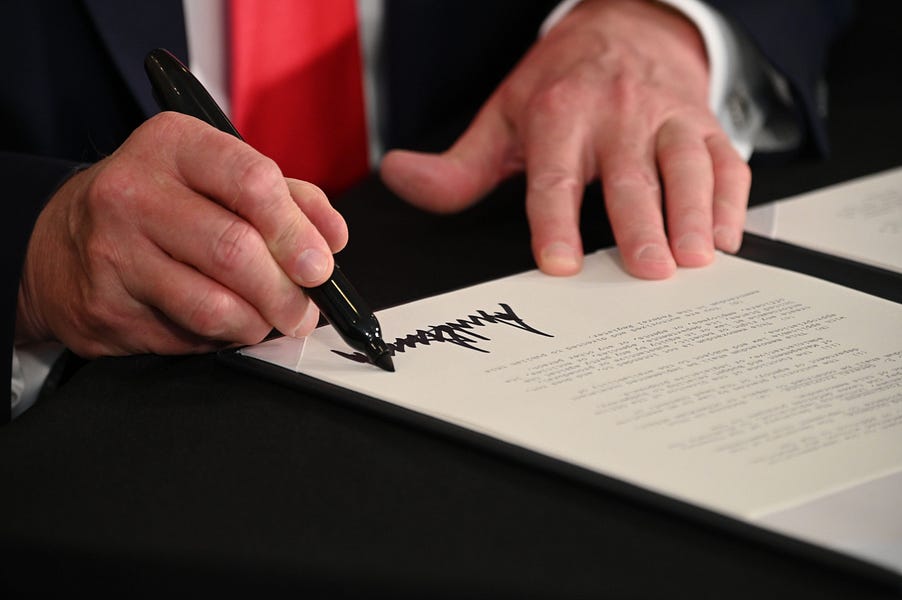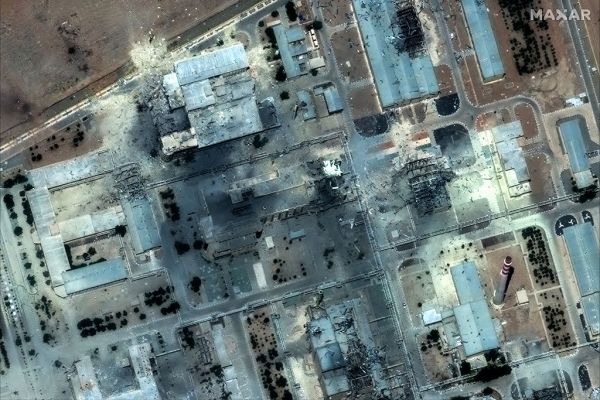As congressional talks to extend federal COVID relief dragged out last week, President Trump repeatedly threatened to take matters into his own hands. On Saturday, he made good on that threat—signing a string of presidential memoranda and executive orders intended to accomplish several priorities his administration had been pushing in the latest round of negotiations.
As legislative asks, those priorities were meaty: Trump wanted Congress to suspend the payroll tax through the end of the year and to renew the CARES Act’s expanded unemployment payments to millions of Americans who remain out of work—payments that lapsed at the end of July. The White House also wanted the next legislation to extend the CARES Act’s moratorium on evictions and to defer student-loan obligations.
President Trump claimed Friday his executive actions would accomplish all those priorities. “If Democrats continue to hold this critical relief hostage,” he said, “I will act under my authority as president to get Americans the relief they need.”
In reality, the orders are somewhat flimsier. The difficulty, of course, is that Congress, not the president, decides how much the federal government spends, and on what. Thus the president’s grand aspirations were limited by the scope of the specific authorizations for redirecting funds that already exist in federal law. Suspending penalties for late student loan payments is possible; unilaterally forbidding evictions is not. (The text of the relevant order quietly acknowledges this, merely directing the federal government to “consider whether any measures temporarily halting residential evictions… are reasonably necessary to prevent the further spread of COVID-19,” without actually ordering such measures of any kind.)
The plan to extend expanded unemployment benefits is similarly tortured: Unable to merely extend the CARES Act’s benefit, the White House has been forced to invoke the 1988 Stafford Act to root around in other pots of congressionally appropriated federal money—in particular, a $43 billion FEMA fund earmarked to provide relief to people affected by natural disasters.
This legal necessity brings with it a whole host of new difficulties. First, rather than simply refueling the existing system for enhanced unemployment, as a legislative solution would have done, this maneuver will likely require states to build out an entirely new system to get that money to their unemployed residents. It could be months before such a system is ready to go.
Second, there’s the stipulation of the Stafford Act that states must match a dollar of their own funds for every three they receive from the federal government—a tall order for states already teetering on the brink of insolvency, though one that’s eased by language in the order permitting them to use unspent CARES Act funds for this purpose.
And that’s to say nothing of the advisability of raiding FEMA budgets in the midst of what is shaping up to be a nasty hurricane season.
The order of the bunch with the potential to have the highest impact concerns the payroll tax. The memorandum instructs the Treasury to stop collecting that tax, which for most full-time workers is automatically withheld as a portion of each paycheck, retroactive from July 1 until the end of the year.
Trump himself has rather baldly tied this measure to his own re-election, promising Saturday that he would forgive the back taxes and make the cuts permanent “if victorious on November 3.” The White House walked that claim back Sunday after Democrats pointed out such an action would likely bankrupt Medicare and Social Security.
There’s no question whatsoever that Trump lacks the authority—either as a first-term president or a second-term one—to forgive those taxes unilaterally.
But at least in theory, he does have legal ground to stand on for this initial delay—although that ground is tenuous. The relevant law, 26 U.S.C. 7508A, is intended to provide tax relief to people affected by federally declared disasters, and gives the government authority to delay their taxes for up to a year. Since the whole country is currently under such a disaster declaration, under the letter of the law the government has an argument here.
It’s not a sure thing: Some experts argue this interpretation stretches the law so far as to be unrecognizable.
“It wasn’t the intent of the legislation,” Joel Griffith, a research fellow at the Heritage Foundation, told The Dispatch on Thursday, before the White House move was official. “It would be just such an unprecedented act to go ahead and declare an entire nation a disaster zone, and then instead of suspended taxes only for those that are impacted, we’re going to suspend it for the entirety of the population. … It would also be a dangerous precedent because in this country, Congress sets the tax policy, and the executive branch is supposed to enforce that law. And if Congress wants to suspend the payroll tax, and the federal government wants to do that, Congress needs to go ahead and pass that legislation, right?”
Trump himself has bolstered the case that he is infringing on Congress’s territory, with rhetoric that, in an echo of President Barack Obama, claims his executive actions were necessary precisely because Congress has failed to carry out his desired objectives.
Nor is it the first time President Trump has used an extraordinarily broad reading of his emergency powers to ram through policy without the approval of Congress. After trying and failing for two years to get Congress to fund his border wall, President Trump finally declared a national emergency at the southern border, invoking in a similarly tortuous way a law giving the president authority over military construction projects. Trump’s trade war with China was also a personal project, conducted by means of legislation allowing the president to restrict trade for purposes of national security—despite his free and repeated acknowledgment that he simply thought putting tariffs on other countries made good financial sense for America.
While Democrats widely denounced the orders Sunday, Republican criticism was more muted. Sen. Susan Collins released a chilly statement saying congressional action was still needed and cautioning that “there are constitutional limits on what the president can do to help through executive orders.” Sen. Ben Sasse was a notable exception, saying in a fiery statement that “the pen-and-phone theory of executive lawmaking is unconstitutional slop.”
So what comes next? Legal challenges are sure to come, but perhaps the more pressing question is whether Congress will still feel the urgency to pass a bill. And not just Congress—after all, the White House has been doing nearly all of the negotiating on behalf of Republican lawmakers for the past few weeks. Now that the executive actions are out there, will they simply declare the mission accomplished and focus on playing defense? Or will they acknowledge those actions for what they are—an ad-hoc workaround to what should rightly be done by legislation—and come back to the table to hammer out a deal at last?
Photograph by Jim Watson/AFP/Getty Images.






Please note that we at The Dispatch hold ourselves, our work, and our commenters to a higher standard than other places on the internet. We welcome comments that foster genuine debate or discussion—including comments critical of us or our work—but responses that include ad hominem attacks on fellow Dispatch members or are intended to stoke fear and anger may be moderated.
With your membership, you only have the ability to comment on The Morning Dispatch articles. Consider upgrading to join the conversation everywhere.